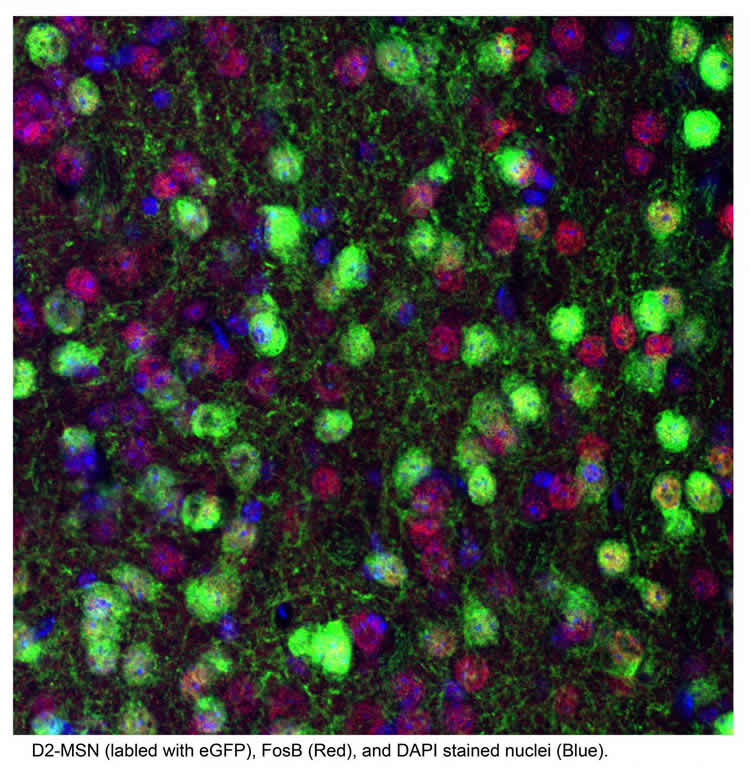Summary: Targeting a protein associated with addiction could help reduce aggression levels, researchers report.
Source: SfN.
Aggressive behavior and the motivation to act aggressively have distinct molecular bases, according to a study of male mice published in Journal of Neuroscience. This finding suggests the possibility of reducing aggression by targeting a protein associated with addiction in a reward region of the brain.
Despite sharing core features with drug addiction, the mechanisms underlying aggression are far less understood. One shared mechanism may involve a transcription factor, ΔFosB, which builds up in the nucleus accumbens (NAc) in response to many different rewarding experiences, including sex and exercise.
Scott Russo, Elizabeth Heller, and colleagues found that higher levels of ΔFosB in NAc neurons were associated with more intense behaviors by aggressive mice defending their home cage from an intruder. Overexpressing ΔFosB in aggressive mice also increased their dominance over an opponent when they faced each other in a narrow tube.
While increased ΔFosB in dopamine D1 receptor expressing medium spiny neurons (D1-MSNs) was associated with increased aggression intensity, mice with increased ΔFosB in D2-MSNs showed less preference for an environment where they previously encountered an intruder.

These results identify distinct roles of ΔFosB in two different NAc cell types that regulate aggressive behavior and its rewarding qualities.
Funding: National Institutes of Health funded this study.
Source: David Barnstone – SfN
Publisher: Organized by NeuroscienceNews.com.
Image Source: NeuroscienceNews.com image is credited to Hossein Aleyasin.
Original Research: Abstract for “Cell-type-specific role of ΔFosB in nucleus accumbens in modulating inter-male aggression” by Hossein Aleyasin, Meghan E. Flanigan, Sam A. Golden, Aki Takahashi, Caroline Menard, Madeline L. Pfau, Jacob Multer, Jacqueline Pina, Kathryn A. McCabe, Naemal Bhatti, Georgia E. Hodes, Mitra Heshmati, Rachael L. Neve, Eric J. Nestler, Elizabeth A. Heller and Scott J. Russo in Journal of Neuroscience. Published June 11 2018
doi:10.1523/JNEUROSCI.0296-18.2018
[cbtabs][cbtab title=”MLA”]SfN “What Makes Aggressive Mice So Violent?.” NeuroscienceNews. NeuroscienceNews, 11 June 2018.
<https://neurosciencenews.com/violence-aggression-9310/>.[/cbtab][cbtab title=”APA”]SfN (2018, June 11). What Makes Aggressive Mice So Violent?. NeuroscienceNews. Retrieved June 11, 2018 from https://neurosciencenews.com/violence-aggression-9310/[/cbtab][cbtab title=”Chicago”]SfN “What Makes Aggressive Mice So Violent?.” https://neurosciencenews.com/violence-aggression-9310/ (accessed June 11, 2018).[/cbtab][/cbtabs]
Abstract
Cell-type-specific role of ΔFosB in nucleus accumbens in modulating inter-male aggression
A growing number of studies implicate the brain’s reward circuitry in aggressive behavior. However, the cellular and molecular mechanisms within brain reward regions that modulate the intensity of aggression as well as motivation for it have been underexplored. Here, we investigate the cell-type-specific influence of ΔFosB, a transcription factor known to regulate a range of reward and motivated behaviors, acting in the nucleus accumbens (NAc)–a key reward region–in male aggression in mice. We show that ΔFosB is specifically increased in dopamine D1 receptor (Drd1) expressing medium spiny neurons (D1-MSNs) in NAc after repeated aggressive encounters. Viral-mediated induction of ΔFosB selectively in D1-MSNs of NAc intensifies aggressive behavior, without affecting the preference for the aggression-paired context in a conditioned place preference (CPP) assay. In contrast, ΔFosB induction selectively in D2-MSNs reduces the time spent exploring the aggression-paired context during CPP without affecting the intensity of aggression per se. These data strongly support a dissociable cell-type-specific role for ΔFosB in the NAc in modulating aggression and aggression reward.
Significance Statement:
Aggressive behavior is associated with several neuropsychiatric disorders and can be disruptive for the individuals as well as their victims. Studies have shown a positive reinforcement mechanism underlying aggressive behavior that shares many common features with drug addiction. Here, we explore the cell-type-specific role of the addiction-associated transcription factor ΔFosB in the nucleus accumbens (NAc) in aggression. We found that ΔFosB expression promotes aggressive behavior, effects that are dissociable from its effects on aggression reward. This finding is a significant first step in identifying therapeutic targets for the reduction of aggressive behavior across a range of neuropsychiatric illnesses.






